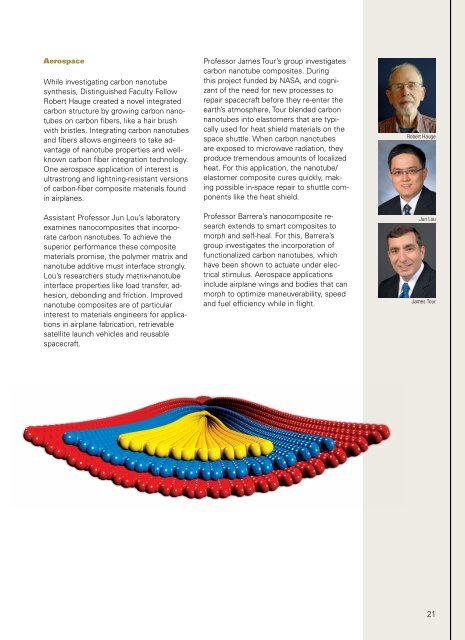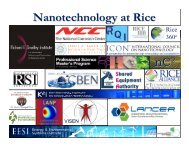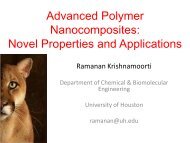Richard E. Smalley Institute for Nanoscale Science and - Center for ...
Richard E. Smalley Institute for Nanoscale Science and - Center for ...
Richard E. Smalley Institute for Nanoscale Science and - Center for ...
Create successful ePaper yourself
Turn your PDF publications into a flip-book with our unique Google optimized e-Paper software.
Aerospace<br />
While investigating carbon nanotube<br />
synthesis, Distinguished Faculty Fellow<br />
Robert Hauge created a novel integrated<br />
carbon structure by growing carbon nanotubes<br />
on carbon fibers, like a hair brush<br />
with bristles. Integrating carbon nanotubes<br />
<strong>and</strong> fibers allows engineers to take advantage<br />
of nanotube properties <strong>and</strong> wellknown<br />
carbon fiber integration technology.<br />
One aerospace application of interest is<br />
ultrastrong <strong>and</strong> lightning-resistant versions<br />
of carbon-fiber composite materials found<br />
in airplanes.<br />
Assistant Professor Jun Lou’s laboratory<br />
examines nanocomposites that incorporate<br />
carbon nanotubes. To achieve the<br />
superior per<strong>for</strong>mance these composite<br />
materials promise, the polymer matrix <strong>and</strong><br />
nanotube additive must interface strongly.<br />
Lou’s researchers study matrix-nanotube<br />
interface properties like load transfer, adhesion,<br />
debonding <strong>and</strong> friction. Improved<br />
nanotube composites are of particular<br />
interest to materials engineers <strong>for</strong> applications<br />
in airplane fabrication, retrievable<br />
satellite launch vehicles <strong>and</strong> reusable<br />
spacecraft.<br />
Professor James Tour’s group investigates<br />
carbon nanotube composites. During<br />
this project funded by NASA, <strong>and</strong> cognizant<br />
of the need <strong>for</strong> new processes to<br />
repair spacecraft be<strong>for</strong>e they re-enter the<br />
earth’s atmosphere, Tour blended carbon<br />
nanotubes into elastomers that are typically<br />
used <strong>for</strong> heat shield materials on the<br />
space shuttle. When carbon nanotubes<br />
are exposed to microwave radiation, they<br />
produce tremendous amounts of localized<br />
heat. For this application, the nanotube/<br />
elastomer composite cures quickly, making<br />
possible in-space repair to shuttle components<br />
like the heat shield.<br />
Professor Barrera’s nanocomposite research<br />
extends to smart composites to<br />
morph <strong>and</strong> self-heal. For this, Barrera’s<br />
group investigates the incorporation of<br />
functionalized carbon nanotubes, which<br />
have been shown to actuate under electrical<br />
stimulus. Aerospace applications<br />
include airplane wings <strong>and</strong> bodies that can<br />
morph to optimize maneuverability, speed<br />
<strong>and</strong> fuel efficiency while in flight.<br />
Robert Hauge<br />
Jun Lou<br />
James Tour<br />
21






